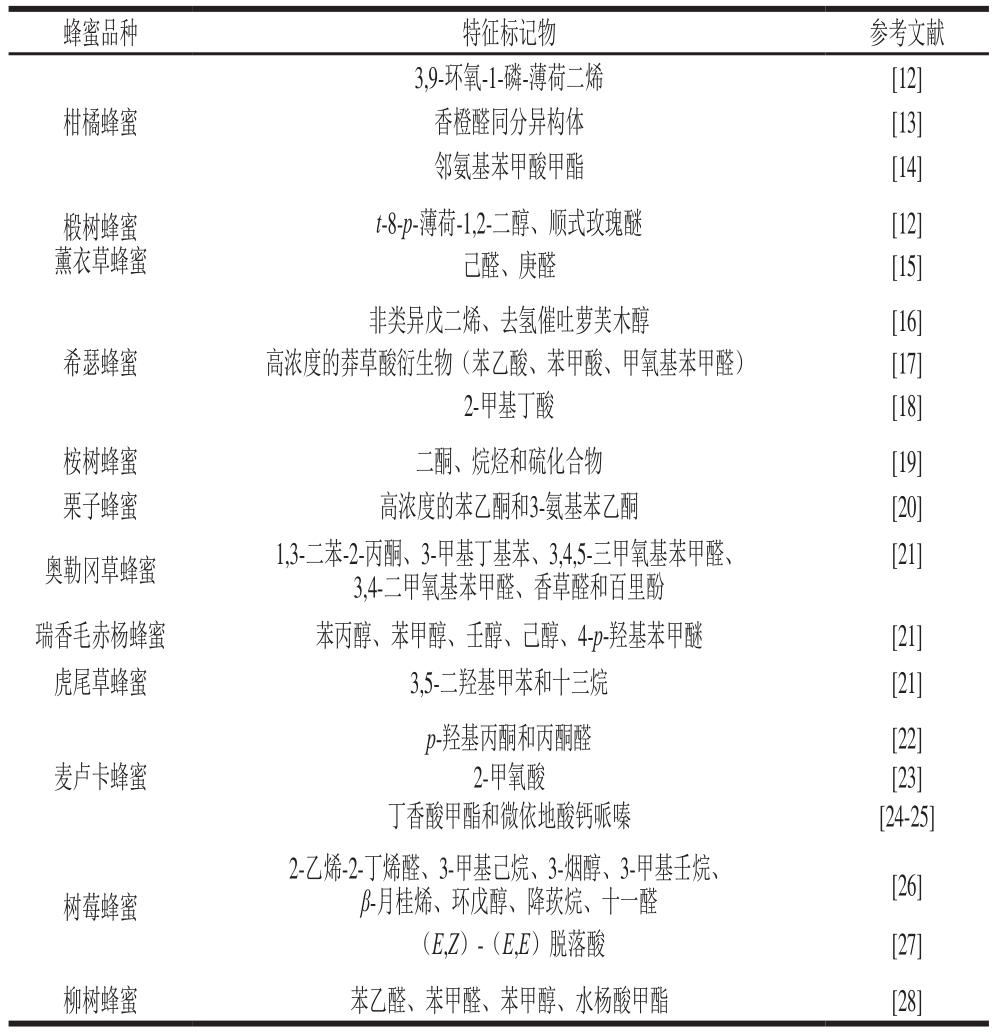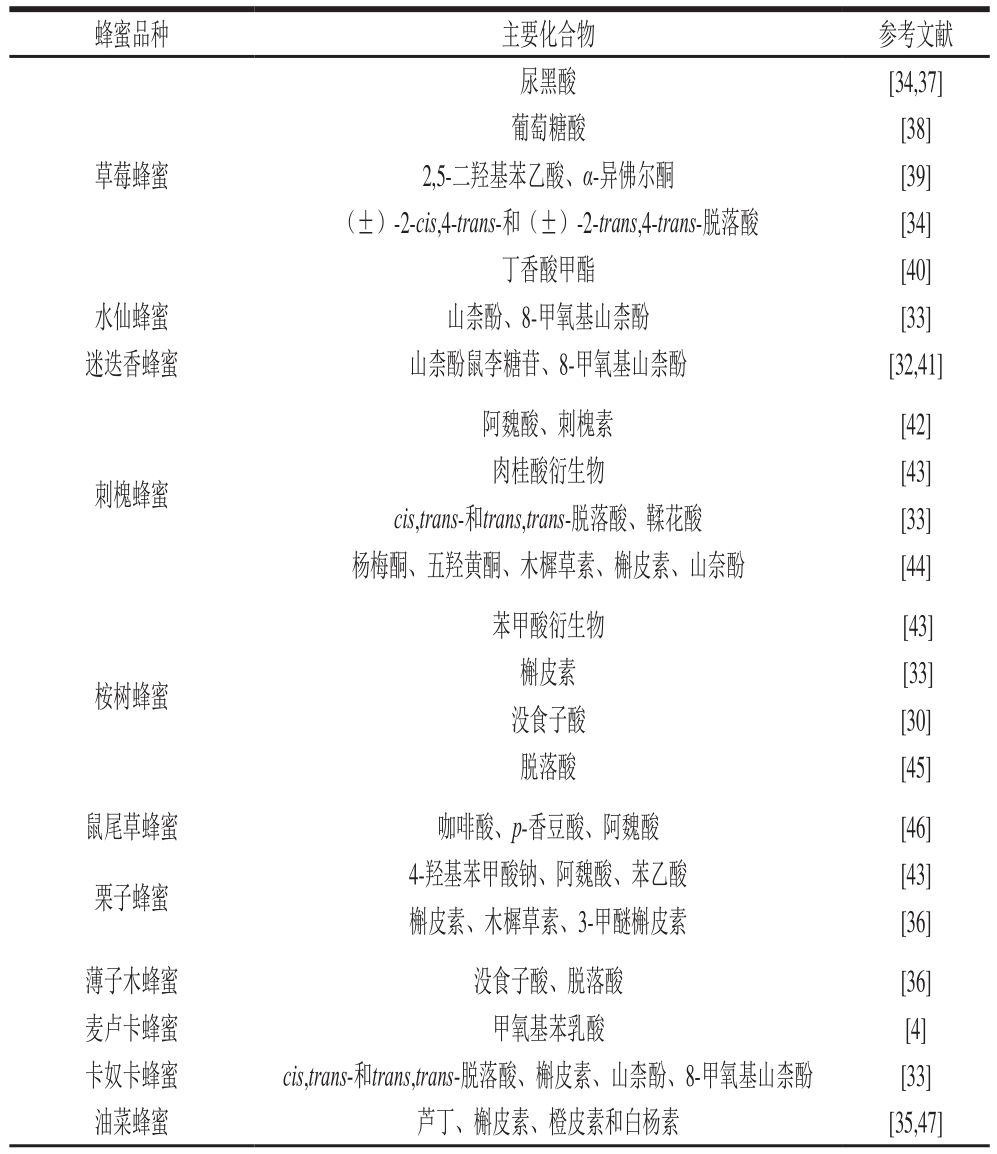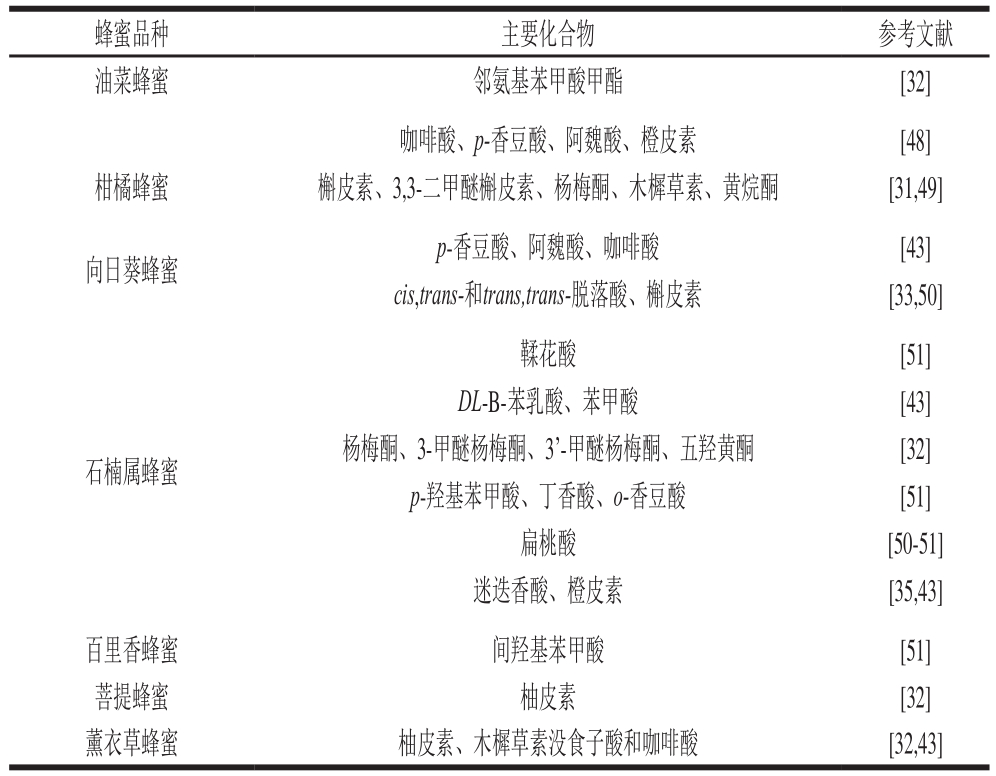表 1 不同品种蜂蜜中的特征挥发性成分
Table 1 Characteristic volatile components in different varieties of honey

梁馨文,李强强,王 凯,吴黎明*
(中国农业科学院蜜蜂研究所,北京 100093)
摘 要:不同品种和产地来源的蜂蜜,其营养成分和市场价值各异。因此,建立有效的蜂蜜溯源鉴别技术对更好地保障蜂蜜的营养品质具有十分重要的意义。本文以国内外研究文献为基础,综述了蜂蜜溯源鉴别的常见方法,包括花粉鉴别和化学物质鉴定,并系统归纳了蜂蜜溯源特征标记物,包括挥发性化合物、酚类物质、糖类、含氮化合物及其他微量元素,为今后进一步实现蜂蜜的准确溯源鉴别提供理论依据。
关键词:蜂蜜溯源;花粉鉴别;特征标记物
蜂蜜是由蜜蜂将采集到的植物花蜜、蜜露或其他植物分泌物与蜜蜂自身分泌物结合并充分酿造而制成的甜味物质。蜂蜜植物来源和地理来源的多样性使其营养成分不尽相同,产品质量和蜂蜜价值存在差异。目前,蜂蜜因其具有的特殊香味和丰富营养价值而深受广大消费者喜爱,其产品需求量在全球市场中逐步增大;然而受经济利益的趋使,市场上频繁出现蜂蜜掺假和以次充好的现象,导致蜂蜜品种、产地标识和市场价格混乱,严重损害了消费者的利益和蜂蜜市场的健康发展。因此,鉴定和验证蜂蜜溯源(包括植物溯源和地理溯源)对蜂蜜的质量安全和品质保障至关重要,更有利于蜂蜜市场的完善和发展。
近年来,大量报道指出,蜂蜜中的特定化学标记物能够反映相应蜜源的溯源信息,通过发掘与蜂蜜植物源和地理源密切相关的化学成分作为溯源标记物,可为蜂蜜溯源识别提供可靠的依据。然而,蜂蜜是一种成分极其复杂的天然物质,其化学成分和属性除受植物源和地理源因素影响外,季节、蜂种、贮藏方式、采集技术等条件同样影响其化学组成,因而进一步加大了蜂蜜溯源识别的难度。由于单个植物化学物质很难准确实现蜂蜜的溯源鉴别,因此需要利用多种植物化学成分综合识别。本文旨在综述近年来国内外发表的关于蜂蜜溯源相关的特征成分,为今后进一步实现蜂蜜的准确溯源鉴别提供理论依据。
蜂蜜溯源鉴别最常见的手段包括花粉鉴别和化学物质鉴定。通过鉴定蜂蜜中含有的花粉种类和数量可以快速简便地判断其植物来源,化学物质鉴定主要是分析蜂蜜品种间和地域间的成分差异,将与蜂蜜植物源和地理源密切相关的化学成分作为溯源标记物,以此实现蜂蜜溯源的准确鉴别。
蜂蜜孢粉学是一种通过分析蜂蜜中的花粉形态和数量来实现蜂蜜溯源鉴别判定的方法。蜂蜜中的花粉成分能够反映蜂蜜的植物来源和地理来源,对区分蜂蜜的品种具有重要意义。利用蜂蜜中的花粉形态鉴别蜂蜜品种是一种较为常用的方法,因为此方法不需要大型仪器设备,小型企业和蜂农个人都可以使用。但利用孢粉学鉴别蜂蜜溯源也存在不足,例如鉴别过程费时、计数过程费力、花粉形态鉴别存在一定困难、结果分析不够准确,且要求检测人员掌握丰富的花粉形态学知识并具备专业技能。文献报道指出,蜂蜜孢粉学具有不确定性,并不适用于快速常规分析[1]。Moar[2]的研究显示蜂蜜中可以含有与其蜜源不相关的花粉。再者,通过蜜蜂行为或者蜂农在养蜂实践中造成的污染也可能会改变蜂蜜中的花粉含量。一些来源于棉花、蓖麻油和橡皮树等植物源的蜂蜜因其花粉含量较少而不能通过蜂蜜孢粉学鉴别。除此之外,Alissandrakis等[3]的报道也证明依据花粉分析不能鉴别出希腊柑橘蜂蜜;Jonathanm等[4]得出因麦卢卡蜂蜜和新西兰的卡奴卡蜂蜜具有相似的花粉粒形态而无法通过花粉分析区分的结论。综上所述,虽然花粉分析作为最早使用鉴别蜂蜜植物源的手段,但由于蜂蜜孢粉学存在局限性,并不能仅依据花粉形态鉴别而达到准确快速鉴别蜂蜜植物源的目的,但可以作为鉴别蜂蜜植物源的辅助参考。
植物化学物质包括挥发性化合物(松烯类、萜烯类、其他挥发性化合物)、酚类物质(黄酮类、非黄酮类)、糖类、含氮化合物(氨基酸类、非氨基酸类)及其他微量元素。
1.2.1 挥发性化合物作为蜂蜜的特征标记物
蜂蜜中的香气物质是区分蜂蜜植物源的特征指标之一,因此,发现与蜂蜜品种密切相关的特定挥发性化合物有利于鉴别蜂蜜植物源。一般情况下,因蜂蜜的香气来自于花蜜或蜜露中的挥发性化合物,故香气成分受蜂蜜植物源和成熟状态的影响。此外,在蜂蜜的热处理和贮藏过程中也可能会形成风味物质[5]。目前,对于蜂蜜香气成分的研究主要集中在总挥发性物质方面,据报道,从不同植物源的蜂蜜样品中能够提取/顶空分离出超过600 种可确定的有机挥发物[6]。蜂蜜中的挥发性化合物可分为7 类:醛、酮、酸、醇、酯、碳氢化合物和环状化合物,存在于蜂蜜中重要的挥发性化合物主要包括威士忌内酯、甲基-p-茴香醛、肉桂酸、柠檬烯二醇、异戊酸、丁香酚、邻氨基苯甲酸甲酯、异佛尔酮、α-蒎烯环氧化物、茴香醚、水杨酸甲酯和紫丁香醛。
大量研究表明,同一鲜花、花蜜及蜂蜜中具有相同的挥发性化合物和/或其代谢物[7],故找出其共有的挥发性化合物可作为蜂蜜的花源标记物。据报道,某些蜂蜜类型可通过一种特征化合物鉴定,如邻氨基苯甲酸甲酯和异佛尔酮可分别作为柑橘蜂蜜[8]及杨梅蜂蜜、杜鹃花科蜂蜜[9]的化学标记物。除此之外,某些挥发性化合物存在于多种蜂蜜中:苯乙醛对栗蜜、桉树蜜、薰衣草蜜的香气具有贡献作用;在薰衣草蜜和金合欢蜜中均含有庚醛;壬醛存在于杜鹃花蜜、荆条蜜、桉树蜜和蜜露中[10],因此绝大多数的蜂蜜品种需多种特征化合物才可以实现鉴别。表1列出了决定蜂蜜香气的主要特征标记物。
蜂蜜中的特征挥发性成分除可作为植物源标记物外,还可用于蜂蜜的地理源鉴定。Radovic等[11]对挥发性成分的判别可将蜂蜜按地理源分类,研究结果表明:1-戊烯-3-醇可作为英国蜂蜜的特征挥发性成分;丹麦蜂蜜中无3-甲基丁醛;2,2,6-三甲基环己酮、乙酸乙酯-2-羟基丙酸、3-己烯-甲酸和一些未确定的化合物为葡萄牙蜂蜜的主要挥发性标记物;存在1-辛烯-3-醇或2,6,6-三甲基-2,4-环庚二烯-1-甲基,且无戊醛和氧化芳樟醇化合物可判定为西班牙蜂蜜。
表 1 不同品种蜂蜜中的特征挥发性成分
Table 1 Characteristic volatile components in different varieties of honey

由此可见,通过香气成分可鉴定不同植物来源或地理来源的蜂蜜品种。但考虑到其他条件的影响,例如不同的气候条件、成熟度、加工处理过程、分离条件、其他植物干扰等因素也可能影响蜂蜜的挥发性化合物组成,因此针对特征的挥发性化合物的测定信息还需进一步完善和补充。
1.2.2 酚类化合物作为蜂蜜的特征标记物
蜂蜜中的酚类化合物主要来源于植物,并可从植物转移到花蜜中[29],蜂蜜的植物源与黄酮类物质有一定的相关性[30]。已报道蜂蜜中包含的主要酚类物质包括阿魏酸、尿黑酸、丁香酸、高良姜素、槲皮素、杨梅酮、山柰酚、犬尿酸、迷迭香酸和脱落酸等。研究发现,蜂蜜中存在的单个特征酚类化合物或者多个酚类化合物都可以作为鉴别蜂蜜植物源的标记化合物:柑橘蜂蜜中含有大量的黄烷酮[31];8-甲氧基山柰酚是迷迭香蜜中主要的酚类化合物[32];柚皮素和木樨草素可作为薰衣草蜜的特征标记物[32];槲皮素是向日葵蜜的特征标记物[33];尿黑酸可作为草莓树蜂蜜的特征标记物[34];芦丁为油菜蜜的标记物之一,石楠花蜜和椴树蜜中都含有橙皮素[35]。表2列出了一些蜂蜜品种中主要的酚类化合物。
由此可见,蜂蜜中的许多酚类物质主要来源于植物,这为不同品种蜂蜜的植物源鉴别提供了一定的依据。但采集季节、环境和加工处理等因素也会影响蜂蜜的酚类化合物成分[36],故仅通过测定酚类物质来判断蜂蜜的植物来源并不能实现准确鉴别。
表 2 不同品种蜂蜜中的特征酚类化合物
Table 2 Characteristic phenolic components in different varieties of honey

续表2

1.2.3 碳水化合物作为蜂蜜的特征标记物
糖是蜂蜜的主要成分,蜂蜜中存在的单糖为果糖和葡萄糖。可通过定量蜂蜜中单糖和寡糖的含量比来判断蜂蜜的品种类型,其中果糖和葡萄糖的含量比可作为鉴别蜂蜜植物源的可靠指标[52],其他碳水化合物的含量比(果糖/葡萄糖、麦芽糖/异麦芽糖、蔗糖/松二糖、麦芽糖/松二糖、麦芽三糖/(棉籽糖+松三糖+吡喃葡糖基蔗糖))也可作为蜂蜜真假鉴别和植物源鉴别指标[53]:在椴树蜜、甘露蜜和阿拉伯树胶蜂蜜中,利用极高的麦芽糖/异麦芽糖比(11∶1~25∶9)可鉴别出阿拉伯树胶蜂蜜[54];通过低果糖/葡萄糖比(小于1)可将油菜蜂蜜、蒲公英蜂蜜和柳树蜂蜜从其他种类蜂蜜中区分出来[55]。除此之外,也可通过定性蜂蜜中糖类成分组成来进行蜂蜜溯源:例如,低浓度的鳄梨糖醇可作为鳄梨蜂蜜的化学标记物[56];Ruiz-Matute等[57]的研究显示,车前糖和α-3-葡糖异麦芽糖仅存在于西班牙和新西兰蜂蜜中;Nozal等[53]运用判别分析方法,发现希瑟蜂蜜中含有高含量的吡喃葡糖基蔗糖和黑曲霉糖,黑森林蜂蜜中含有高含量的海藻糖和松三糖,薰衣草蜜中含有异麦芽糖,法国薰衣草蜜和百里香蜜中含有潘糖。此外,多类物质结合也可实现蜂蜜溯源鉴别,麦芽糖、蔗糖结合邻苯二甲酸或2-甲基庚酸等挥发性化合物的含量可作为鉴别蜂蜜植物源和地理源的信息指标[58],Truchado等[59]提出黄酮苷类和硫代葡萄糖苷可作为阿根廷二行芥属蜂蜜的植物源标记物。
值得注意的是,当优势植物蜜源所占比例较大时,糖类成分和比例可作为蜂蜜品种分类和真实认证的可靠指标;但当优势植物蜜源所占比例下降时,对糖类测量结果的解释变得更加困难,几乎不能够作为这类蜂蜜的鉴别依据。
1.2.4 氨基酸和蛋白质作为可能的蜂蜜特征标记物
氨基酸可作为鉴别蜂蜜品种的潜在特征标记物:薰衣草蜂蜜中含有较高浓度的酪氨酸[60];在百里香蜂蜜、杜鹃蜂蜜、甘蓝蜂蜜和洋槐蜂蜜4 种蜂蜜中,百里香蜂蜜中具有高含量的脯氨酸[53];通过谷氨酸和色氨酸的含量可区分同一地区的蜜露和蜂蜜[61];Boffo等[62]发现野花蜜中苯基丙氨酸和酪氨酸含量较高,柑橘蜜中含有较高浓度的乳酸;另外,Rebane等[63]研究发现,α-丙氨酸、β-丙氨酸、天冬氨酸、γ-氨基丁酸、谷氨酸、甘氨酸、组氨酸、鸟氨酸、苯丙氨酸、脯氨酸、丝氨酸和色氨酸可作为爱沙尼亚蜂蜜的花源标志物,鸟氨酸可用来鉴别薄荷蜜,谷氨酸可用来鉴别油菜蜜,脯氨酸、精氨酸和苯丙氨酸可以用来鉴别石楠属花蜜;Senyuva等[58]的研究结果显示苯丙氨酸和酪氨酸含量有助于区分土耳其蜂蜜品种,缬氨酸、亮氨酸、异亮氨酸及其他重要的氨基酸可作为蜂蜜植物源和地理源的特征标记物。
一般情况下,测定5~7 种氨基酸并结合化学计量学能够实现蜂蜜地理源和植物源的鉴定。此外,也可将1~2 种氨基酸结合植物化学物质(包括挥发性化合物或低聚糖)共同作为鉴别指标以提高鉴别准确率。但是,由于蜂蜜中氨基酸含量较少,使得利用氨基酸来鉴别蜂蜜品种较为困难。
蛋白质的测定也可追踪蜂蜜植物源。Baroni等[64]应用免疫印迹法分析蜂蜜中的蛋白质,结果表明其能够区分向日葵蜂蜜和桉树蜂蜜。Wang Jun等[65]通过建立蜂蜜蛋白的指纹图谱和条形码实现蜂蜜植物源和地理源的鉴别。此方法虽具有一定的应用前景,但其费用昂贵,且需要收集大量的不同类型的蜂蜜,存在一定的难度。
1.2.5 其他有机化合物和微量元素作为蜂蜜的特征标记物
蜂蜜中其他类型化学物质也可描述蜂蜜溯源:Beretta等[66]的研究结果表明甘露蜂蜜中存在脂肪族化合物,栗子蜂蜜中含有犬尿喹啉酸及其相关代谢产物,自由和/或共轭环己烷-1,3-二烯-1-羧酸存在于柳树蜂蜜中;4-羟基喹啉酸、4-喹诺酮-2-羧酸[40]、犬尿酸、3-氨基苯乙酮和1-苯乙醇[67]均可作为栗树蜂蜜的特征标记物;Donarski等[39]的研究也证明犬尿酸也可作为甜栗蜂蜜的标记物;2-甲氧基苯甲酸、甲基乙二醛、丁香酸甲酯、二羟基丙酮和微量依地酸钙哌嗪[68]可作为鉴别麦卢卡蜂蜜的特征标记物,其中丁香酸甲酯也可用来描述卡奴卡蜂蜜[4]。
蜂蜜中的微量元素也可用于品种鉴别:西班牙桉树蜂蜜、希瑟蜂蜜、橙蜜和迷迭香蜂蜜中Zn、Mn、Mg、Na 4 种元素与植物种类密切相关[69];甘露蜜中具有丰富的K、Al、Ni、Cd、Zn,而油菜蜂蜜中的Na、Ba、Pb可作为其特征标记物[70];吴招斌等[71]研究发现δ13Ch、δ2H、δ18O、K、Ca、Cu、Sr和Ba是鉴别蜂蜜品种的特征元素;魏月等[72]的研究结果表明通过对Mg、K、Ca、Cr、Mn、Sr、Pb 7 种元素的测定,可实现云南苕子蜜、石榴蜜、橡胶蜜和咖啡蜜的鉴别。蜂蜜中有些矿物质因来源于植物源而可作为化学标记物,但蜂蜜中的Pb和Cd等矿物质可能来源于环境污染,故此类矿物质作为化学标记物存在偏差,使得利用微量元素鉴定蜂蜜品种仍具有一定的难度。
通过对蜂蜜化学成分的分析可获得关于蜂蜜产品(尤其是当蜂蜜产品来源于同一植物源)及其植物源相关的重要信息。蜂蜜中一些挥发性化合物、多酚、糖类及一些其他成分都与蜂蜜的植物源相关,每种植物的花蜜类型仍然是决定蜂蜜成分的重要因素之一。此外,一些外在或内在因素同样会引起蜂蜜成分的变化,故仅利用花卉植物的化学成分和植物化学物质来鉴别蜂蜜的植物源和地理源存在一定的偏差。因此利用多种化合物(挥发性物质、酚类化合物、氨基酸、碳水化合物)结合一些辅助参数(电导率、色泽、酶活力)能够更加准确地鉴别蜂蜜品种。除此之外,多元统计方法也是对蜂蜜身份验证和质量控制的一个重要补充工具。
参考文献:
[1] ALISSANDRAKIS E, TARANTILIS P A, HARIZANIS P C, et al.Evaluation of four isolation techniques for honey aroma compounds[J].Journal of the Science of Food and Agriculture, 2005, 85(1): 91-97.DOI:10.1002/jsfa.1934.
[2] MOAR N T. Pollen analysis of New Zealand honey[J]. New Zealand Journal of Agricultural Research, 1985, 28(1): 39-70. DOI:10.1080/00 288233.1985.10426997.
[3] ALISSANDRAKIS E, TARANTILIS P A, HARIZANIS P C, et al.Aroma investigation of unifloral Greek citrus honey using solid-phase microextraction coupled to gas chromatographic-mass spectrometric analysis[J]. Food Chemistry, 2007, 100(1): 396-404. DOI:10.1016/j.foodchem.2005.09.015.
[4] JONATHANM S, RALFC S, BRUCED M, et al. Phenolic compounds and methylglyoxal in some New Zealand manuka and kanuka honeys[J]. Food Chemistry, 2010, 120(1): 78-86. DOI:10.1016/j.foodchem.2009.09.074.
[5] SORIA A C, MARTÍNEZ-CASTRO I, SANZ J. Analysis of volatile composition of honey by solid phase microextraction and gas chromatography-mass spectrometry[J]. Journal of Separation Science,2003, 26(9/10): 793-801. DOI:10.1002/jssc.200301368.
[6] JERKOVIĆ I, MARIJANOVIĆ Z. A short review of headspace extraction and ultrasonic solvent extraction for honey volatiles fingerprinting[J]. Croatian Journal of Food Science and Technology,2009, 1(2): 28-34.
[7] MOREIRA R F A, MARIA C A B D. Investigation of the aroma compounds from headspace and aqueous solution from the cambará(Gochnatia velutina) honey[J]. Flavour & Fragrance Journal, 2005,20(1): 13-17. DOI:10.1002/ffj.1396.
[8] ALISSANDRAKIS E, TARANTILIS P A, HARIZANIS P C, et al.Comparison of the volatile composition in thyme honeys from several origins in Greece[J]. Journal of Agricultural and Food Chemistry,2007, 55(20): 8152-8157. DOI:10.1021/jf071442y.
[9] FUENTE E D L, SANZ M L, MARTÍNEZ-CASTRO I, et al. Volatile and carbohydrate composition of rare unifloral honeys from Spain[J]. Food Chemistry, 2007, 105(1): 84-93. DOI:10.1016/j.foodchem.2007.03.039.
[10] BURDOCK G A. Fenaroli’s handbook of flavor ingredients[M].Fenarolis Handbook of Flavor Ingredients, 1976: 147-149.
[11] RADOVIC B S, CARIERI M, MANGIA A, et al. Contribution of dynamic headspace GC-MS analysis of aroma compounds to authenticity testing of honey[J]. Food Chemistry, 2001, 72(4): 511-520. DOI:10.1016/S0308-8146(00)00263-6.
[12] BLANK I, FISCHER K H, GROSCH W. Intensive neutral odourants of linden honey differences from honeys of other botanical origin[J].European Food Research and Technology, 1989, 189(5): 426-433.
[13] CASTROV-ÁZQUEZ L, DÍAZ-MAROTO M C, PÉREZ-COELLO M S. Aroma composition and new chemical markers of Spanish citrus honeys[J]. Food Chemistry, 2007, 103(2): 601-606. DOI:10.1016/j.foodchem.2006.08.031.
[14] CASTROV-ÁZQUEZ L, DÍAZ-MAROTO M C, GONZÁLEZVIÑAS M A, et al. Differentiation of monofloral citrus, rosemary,eucalyptus, lavender, thyme and heather honeys based on volatile composition and sensory descriptive analysis[J]. Food Chemistry,2009, 112(4): 1022-1030. DOI:10.1016/j.foodchem.2008.06.036.
[15] BOUSETA A, COLLIN S, DUFOUR J P. Characteristic aroma profiles of unifloral honeys obtained with a dynamic headspace GCMS system[J]. Journal of Apicultural Research, 1992, 31(2): 96-109.DOI:10.1080/00218839.1992.11101268.
[16] KANG J Y, ROH T H, HWANG S M, et al. The precursors and flavor constituents of the cooked oyster flavor[J]. Korean Journal of Fisheries and Aquatic Sciences, 2010, 43(6): 606-613. DOI:10.5657/kfas.2010.43.6.606.
[17] GUYOT C, SCHEIRMAN V, COLLIN S. Floral origin markers of heather honeys: Calluna vulgaris and Erica arborea[J]. Food Chemistry, 1999, 64(1): 3-11. DOI:10.1016/S0308-8146(98)00122-8.
[18] SEISONEN S, KIVIMA E, VENE K. Characterisation of the aroma profiles of different honeys and corresponding flowers using solidphase microextraction and gas chromatography-mass spectrometry/olfactometry[J]. Food Chemistry, 2015, 169: 34-40. DOI:10.1016/j.foodchem.2014.07.125.
[19] PÉREZ R A, SÁNCHEZ-BRUNETE C, CALVO R M, et al. Analysis of volatiles from Spanish honeys by solid-phase microextraction and gas chromatography-mass spectrometry[J]. Journal of Agricultural &Food Chemistry, 2002, 50(9): 2633-2637. DOI:10.1021/jf011551r.
[20] BONVEHí J S, COLL F V. Flavour index and aroma profiles of fresh and processed honeys[J]. Journal of the Science of Food &Agriculture, 2003, 83(4): 275-282. DOI:10.1002/jsfa.1308.
[21] ODEH I, ABULAFI S, DEWIK H, et al. A variety of volatile compounds as markers in Palestinian honey from Thymus capitatus,Thymelaea hirsuta, and Tolpis virgata[J]. Food Chemistry, 2007,101(4): 1393-1397. DOI:10.1016/j.foodchem.2006.03.046.
[22] WINDSOR S, PAPPALARDO M, BROOKS P, et al. A convenient new analysis of dihydroxyacetone and methylglyoxal applied to Australian Leptospermum honeys[J]. Journal of Pharmacognosy and Phytotherapy, 2012, 4(1): 6-11. DOI:10.5897/JPP11.025.
[23] BEITLICH N, KOELLINGSPEER I, OELSCHLAEGEL S, et al.Differentiation of manuka honey from kanuka honey and from jelly bush honey using HS-SPME-GC/MS and UHPLC-PDA-MS/MS[J].Journal of Agricultural & Food Chemistry, 2014, 62(27): 6435-6444.DOI:10.1021/jf501818f.
[24] KATO Y, FUJINAKA R, ISHISAKA A, et al. plausible authentication of manuka honey and related products by measuring leptosperin with methyl syringate[J]. Journal of Agricultural and Food Chemistry,2014, 62(27): 6400-6407. DOI:10.1021/jf501475h.
[25] KATO Y, UMEDA N, MAEDA A, et al. Identification of a novel glycoside, leptosin, as a chemical marker of manuka honey[J]. Journal of Agricultural and Food Chemistry, 2012, 60(13): 3418-3423.DOI:10.1021/jf300068w.
[26] ŠPÁNIK I, JANÁČOVÁ Z, ŠUSTEROVÁ, et al. Characterisation of VOC composition of Slovak monofloral honeys by GC×GC-TOF-MS[J]. Chemical Papers, 2013, 67(2): 127-134. DOI:10.2478/s11696-012-0254-z.
[27] SENG T T, WILKINS A L, HOLLAND P T, et al. Extractives from New Zealand honeys. 3. unifloral thyme and willow honey constituents[J]. Journal of Agricultural and Food Chemistry, 1990,38(9): 1833-1838. DOI:10.1021/jf00099a010.
[28] JERKOVIĆ I, KUŚ P M, TUBEROSO C I G, et al. Phytochemical and physical-chemical analysis of Polish willow (Salix spp.) honey:identification of the marker compounds[J]. Food Chemistry, 2014,145(4): 8-14. DOI:10.1016/j.foodchem.2013.08.004.
[29] GHELDOF N, ENGESETH N J. Antioxidant capacity of honeys from various floral sources based on the determination of oxygen radical absorbance capacity and inhibition of in vitro lipoprotein oxidation in human serum samples[J]. Journal of Agricultural and Food Chemistry,2002, 50(10): 3050-3055. DOI:10.1021/jf0114637.
[30] YAO L, JIANG Y, SINGANUSONG R, et al. Phenolic acids and abscisic acid in Australian Eucalyptus honeys and their potential for floral authentication[J]. Food Chemistry, 2004, 86(2): 169-177.DOI:10.1016/j.foodchem.2003.08.013.
[31] FEDERICO F, CHRISTINA G, FRANCISCO T, et al. Hesperetin: a marker of the floral origin of citrus honey[J]. Journal of the Science of Food and Agriculture, 1993, 61(1): 121-123. DOI:10.1002/jsfa.2740610119.
[32] FERRERES F, TOMAS BARBERAN F A, SOLER C, et al. A simple extractive technique for honey flavonoid HPLC analysis[J].Apidologie, 1994, 25(1): 21-30. DOI:10.1051/apido:19940103.
[33] TOMÁS-BARBERÁN F A, MARTOS I, FERRERES F, et al. HPLC flavonoid profiles as markers for the botanical origin of European unifloral honeys[J]. Journal of the Science of Food and Agriculture,2001, 81(5): 485-496. DOI:10.1002/jsfa.836.
[34] TUBEROSO C I G, BIFULCO E, CABONI P, et al. Floral markers of strawberry tree (Arbutus unedo L.) honey[J]. Journal of Agricultural and Food Chemistry, 2010, 58(1): 384-389. DOI:10.1021/jf9024147.
[35] SERGIEL I, POHL P, BIESAGA M. Characterisation of honeys according to their content of phenolic compounds using high performance liquid chromatography/tandem mass spectrometry[J].Food Chemistry, 2014, 145(4): 404-408. DOI:10.1016/j.foodchem.2013.08.068.
[36] YAO L, DATTA N, TOMÁSBARBERÁN F A, et al. Flavonoids,phenolic acids and abscisic acid in Australian and New Zealand Leptospermum honeys[J]. Food Chemistry, 2003, 81(2): 159-168.DOI:10.1016/S0308-8146(02)00388-6.
[37] CABRAS P, ANGIONI A, TUBEROSO C, et al. Homogentisic acid: a phenolic acid as a marker of strawberry-tree (Arbutus unedo) honey[J].Journal of Agricultural and Food Chemistry, 1999, 47(10): 4064-4067.DOI:10.1021/jf990141o.
[38] CHERCHI A, SPANEDDA L, TUBEROSO C, et al. Solid-phase extraction and high-performance liquid chromatographic determination of organic acids in honey[J]. Journal of Chromatography A, 1994,669(1/2): 59-64. DOI:10.1016/0021-9673(94)80336-6.
[39] DONARSKI J A, JONES S A, HARRISON M, et al. Identification of botanical biomarkers found in Corsican honey[J]. Food Chemistry,2010, 118(4): 987-994. DOI:10.1016 /j.foodchem.2008.10.033.
[40] TUBEROSO C I G, BIFULCO E, JERKOVIĆ I, et al. Methyl syringate: a chemical marker of asphodel (Asphodelus microcarpus Salzm. et Viv.) monofloral honey[J]. Journal of Agricultural and Food Chemistry, 2009, 57(9): 3895-3900. DOI:10.1021/jf803991j.
[41] TRUCHADO P, MARTOS I, BORTOLOTTI L, et al. Use of quinoline alkaloids as markers of the floral origin of chestnut honey[J].Journal of Agricultural and Food Chemistry, 2009, 57(13): 5680-5686.DOI:10.1021/jf900766v.
[42] BOBIS O, MǍRGHITAŞ L A, BONTA V, et al. Free phenolic acids, flavonoids and abscisic acid related to HPLC sugar profile in acacia honey[J]. Buletin USAMV-CN, 2007, 64: 179-185. DOI:10.15835/buasvmcn-asb:64:1-2:2230.
[43] DIMITROVA B, GEVRENOVA R E. Analysis of phenolic acids in honeys of different floral origin by solid-pase extraction and highperformance liquid chromatography[J]. Phytochemical Analysis, 2007,18(1): 24-32. DOI:10.1021/cr980070c.
[44] MARTOS I, FERRERES F, TOMÁSBARBERÁN F A. Identification of flavonoid markers for the botanical origin of Eucalyptus honey[J].Journal of Agricultural and Food Chemistry, 2000, 48(5): 1498-1502.DOI:10.1021/jf991166q.
[45] KENJERIĆ D, MANDIĆ M L, PRIMORAC L, et al. Flavonoid pattern of sage (Salvia officinalis L.) unifloral honey[J]. Food Chemistry,2008, 110(1): 187-192. DOI:10.1016/j.foodchem.2008.01.031.
[46] CHERCHI A, SPANEDDA L, TUBEROSO C, et al. Solid-phase extraction and high-performance liquid chromatographic determination of organic acids in honey[J]. Journal of Chromatography A, 1994,669(1/2): 59-64. DOI:10.1016/0021-9673(94)80336-6.
[47] HADJMOHAMMADI M R, NAZARI S, KAMEL K. Determination of flavonoid markers in honey with SPE and LC using experimental design[J]. Chromatographia, 2009, 69(11/12): 1291-1297.DOI:10.1365/s10337-009-1073-4.
[48] LIANG Y, CAO W, CHEN W, et al. Simultaneous determination of four phenolic components in citrus honey by high performance liquid chromatography using electrochemical detection[J]. Food Chemistry,2009, 114(4): 1537-1541. DOI:10.1016/j.foodchem.2008.11.024.
[49] YAO L, JIANG Y, SINGANUSONG R, et al. Flavonoids in Australian Melaleuca, Guioa, Lophostemon, Banksia and Helianthus honeys and their potential for floral authentication[J]. Food Research International,2004, 37(2): 166-174. DOI:10.1016/j.foodres.2003.11.004.
[50] FERRERES F, ANDRADE P, TOMASBARBERAN F A. Natural occurrence of abscisic acid in heather honey and floral nectar[J].Journal of Agricultural and Food Chemistry, 1996, 44(8): 2053-2056.DOI:10.1021/jf9507553.
[51] ANDRADE P, FERRERES F, AMARAL M T. Analysis of honey phenolic acids by HPLC, its application to honey botanical characterization[J]. Journal of Liquid Chromatography & Related Technologies, 1997, 20(14): 2281-2288. DOI:10.1080/10826079708006563.
[52] ODDO L P, PIRO R, FLAMIN C, et al. Main European unifloral honeys: descriptive sheets[J]. Apidologie (Celle), 2004, 35(Suppl 1):S38-S81. DOI:10.1051/apido:2004049.
[53] NOZAL M J, BERNAL J L, TORIBIO L, et al. The use of carbohydrate profiles and chemometrics in the characterization of natural honeys of identical geographical origin[J]. Journal of Agricultural and Food Chemistry, 2005, 53(8): 3095-3100. DOI:10.1021/jf0489724.
[54] HORVÁTH K, MOLNÁR-PERL I. Simultaneous quantitation of mono-, di- and trisaccharides by GC-MS of their TMS ether oxime derivatives: II. in honey[J]. Chromatographia, 1997, 45(1): 328-335.DOI:10.1007/BF02505579.
[55] KAŠKONIENĖ V, VENSKUTONIS P R, ČEKSTERYTĖ V.Carbohydrate composition and electrical conductivity of different origin honeys from Lithuania[J]. LWT-Food Science and Technology,2010, 43(5): 801-807. DOI:10.1016/j.lwt.2010.01.007.
[56] DVASH L, AFIK O, SHAFIR S, et al. Determination by near-infrared spectroscopy of perseitol used as a marker for the botanical origin of avocado (Persea americana Mill.) honey[J]. Journal of Agricultural and Food Chemistry, 2002, 50(19): 5283-5287. DOI:10.1021/jf020329z.
[57] RUIZ-MATUTE A I, BROKL M, SORIA A C, et al. Gas chromatographic-mass spectrometric characterisation of tri- and tetrasaccharides in honey[J]. Food Chemistry, 2010, 120(2): 637-642.DOI:10.1016/j.foodchem.2009.10.050.
[58] SENYUVA H Z, GILBERT J, SILICI S, et al. Profiling Turkish honeys to determine authenticity using physical and chemical characteristics[J]. Journal of Agricultural and Food Chemistry, 2009,57(9): 3911-3919. DOI:10.1021/jf900039s.
[59] TRUCHADO P, TOURN E, GALLEZ L M, et al. Identification of botanical biomarkers in argentinean diplotaxis honeys: flavonoids and glucosinolates[J]. Journal of Agricultural and Food Chemistry, 2010,58(24): 12678-12685. DOI:10.1021/jf103589c.
[60] HERMOSíN I, CHICóN R M, CABEZUDO M D. Free amino acid composition and botanical origin of honey[J]. Food Chemistry, 2003,83(2): 263-268. DOI:10.1016/S0308-8146(03)00089-X.
[61] IGLESIAS M T, DE L C, DEL C P M, et al. Usefulness of amino acid composition to discriminate between honeydew and floral honeys. application to honeys from a small geographic area[J]. Journal of Agricultural and Food Chemistry, 2004, 52(1): 84-89. DOI:10.1021/jf030454q.
[62] BOFFO E F, TAVARES L A, TOBIAS A C T, et al. Identification of components of Brazilian honey by1H NMR and classification of its botanical origin by chemometric methods[J]. LWT-Food Science and Technology, 2012, 49(1): 55-63. DOI:10.1016/j.lwt.2012.04.024.
[63] REBANE R, HERODES K. Evaluation of the botanical origin of estonian uni- and polyfloral honeys by amino acid content[J]. Journal of Agricultural and Food Chemistry, 2008, 56(22): 10716-10720.DOI:10.1021/jf8018968.
[64] BARONI M V, CHIABRANDO G A, COSTA C, et al. Assessment of the floral origin of honey by SDS-PAGE immunoblot techniques[J].Journal of Agricultural and Food Chemistry, 2002, 50(6): 1362-1367.DOI:10.1021/jf011214i.
[65] WANG Jun, KLIKS M M, QU Weiyue, et al. Rapid determination of the geographical origin of honey based on protein fingerprinting and barcoding using MALDI TOF MS[J]. Journal of Agricultural and Food Chemistry, 2009, 57(21): 10081-10088. DOI:10.1021/jf902286p.
[66] BERETTA G, CANEVA E, REGAZZONI L, et al. A solid-phase extraction procedure coupled to1H NMR, with chemometric analysis, to seek reliable markers of the botanical origin of honey[J].Analytica Chimica Acta, 2008, 620(1/2): 176-182. DOI:10.1016/j.aca.2008.05.025.
[67] BERATTA G, CANEVA E, FACINO R M. Kynurenic acid in honey from arboreal plants: MS and NMR evidence[J]. Planta Medica, 2007,73(15): 1592-1595. DOI:10.1055/s-2007-993740.
[68] K A T O Y, A R A K I Y, J U R I M, e t a l. C o m p e titiv e immunochromatographic assay for leptosperin as a plausible authentication marker of manuka honey[J]. Food Chemistry, 2015,194(3): 362-365. DOI:10.1016/j.foodchem.2015.08.014.
[69] FERNÁNDE-TORRES R, PÉREZ-BERNAL J L, BELLO-LÓPEZ M Á, et al. Mineral content and botanical origin of Spanish honeys[J].Talanta, 2005, 65(3): 686-691. DOI:10.1016/j.talanta.2004.07.030.
[70] CHUDZINSKA M, BARALKIEWICZ D. Estimation of honey authenticity by multielements characteristics using inductively coupled plasma-mass spectrometry (ICP-MS) combined with chemometrics[J].Food and Chemical Toxicology, 2010, 48(1): 284-290. DOI:10.1016/j.fct.2009.10.011.
[71] 吴招斌, 陈芳, 陈兰珍, 等. 基于电感耦合等离子体质谱法和化学计量学鉴别蜂蜜品种研究[J]. 光谱学与光谱分析, 2015, 35(1):217-222. DOI:10.3964/j.issn.1000-0593(2015)01-0217-06.
[72] 魏月, 陈芳, 王勇, 等. ICP-MS用于云南南部四种特色蜂蜜的植物源鉴别分析[J]. 光谱学与光谱分析, 2016, 36(1): 262-267.DOI:10.3964/j.issn.1000-0593(2016)01-0262-06.
A Review of Characteristic Markers for Honey Traceability
LIANG Xinwen, LI Qiangqiang, WANG Kai, WU Liming*
(Institute of Apicultural Research, Chinese Academy of Agricultural Sciences, Beijing 100093, China)
Abstract:The nutritional composition and market value of honey are determined by its floral variety and geographical origin. In order to ensure the nutritional quality of honey, it is extremely important to establish effective methods for the identification of honey traceability. The aim of this article is to review the commonly used methods reported in the literature for honey traceability including identification of pollen and chemical components. Herein we summarize the characteristic markers for honey traceability such as volatile compounds, phenolics, sugar, nitrogen compounds and other trace elements.Hopefully, this review will provide useful information for accurate traceability of honey in the future.
Keywords:honey traceability; pollen identification; characteristic markers
DOI:10.7506/spkx1002-6630-201815049
收稿日期:2017-05-16
基金项目:中国农业科学院科技创新工程项目(CAAS-ASTIP-2016-IAR);现代农业产业技术体系建设专项(CARS-45)
第一作者简介:梁馨文(1992—),女,硕士研究生,研究方向为蜂产品质量与安全。E-mail:liangxinwen2017@126.com
*通信作者简介:吴黎明(1973—),男,研究员,博士,研究方向为蜜蜂饲养管理学和蜂产品加工。E-mail:apiswu@126.com
中图分类号:S896.1
文献标志码:A
文章编号:1002-6630(2018)15-0343-06
引文格式:
梁馨文, 李强强, 王凯, 等. 蜂蜜溯源特征标记物研究进展[J]. 食品科学, 2018, 39(15): 343-348. DOI:10.7506/spkx1002-6630-201815049. http://www.spkx.net.cn
LIANG Xinwen, LI Qiangqiang, WANG Kai, et al. A review of characteristic markers for honey traceability[J]. Food Science,2018, 39(15): 343-348. (in Chinese with English abstract) DOI:10.7506/spkx1002-6630-201815049. http://www.spkx.net.cn